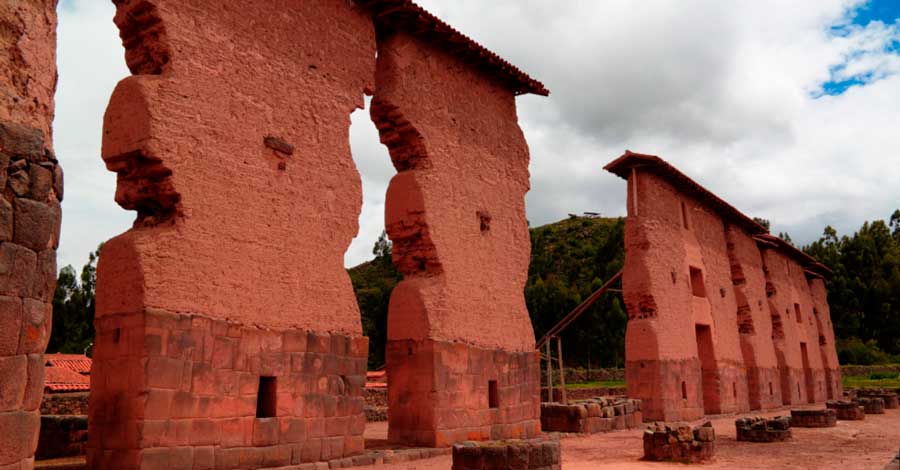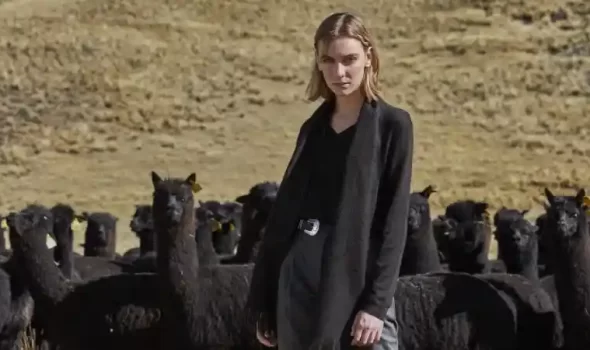Raqchi, in this great Inca llaqta we find a large central building, sixty residences, two hundred deposits, a fountain and a paved pond. What were they? What destiny did they fulfill? The archaeological complex of Raqchi is still shrouded in mystery. In this article we will see with Auri many aspects and some theories about the place called “The temple of Wiracocha”.
Where is Raqchi and at what altitude is it located?
Raqchi is located 122 kilometers southeast of Cusco, on a plain of the same name and on the right bank of the Vilcanota River. Raqchi is located in the district of San Pedro de Cacha in the province of Canchis. The territory of the entire archaeological complex ranges from 3,450 to 3,550 meters / 11,318 to 11,646 feet of altitude.

Etymology What does Raqchi/Racchi mean?
According to the “Academia Mayor de la Lengua Quechua”, Raqchi means “Geol”. A material of volcanic origin (in this case from the Kinsachata volcano very close to this Inca complex) used for pottery, that is, ceramic works. The ceramic material elaborated in the village receives the name “Raqchi”.
On the other hand, it is believed that the real name of the place was Kacha, as Garcilazo de la Vega refers in his “Comentarios Reales de los Incas” (Royal Commentaries of the Incas). According to Gonzales Holguin’s dictionary (a Jesuit researcher of the Quechua language), Kacha means messenger or envoy. The name would derive from some legends described by the chroniclers.
Climate of Raqchi:
The climate is practically the same as that of the city of Cusco with very slight variations in temperature. As in the entire Andean region, there are two well-defined seasons: dry season (May to November) and rainy season (November to May). The average annual temperature varies between 12 and 24°C during the day, and is cooler at night. Both are seasonal.
The legend about Raqchi
Some chroniclers who wrote about Raqchi directly from the mouths of primitive inhabitants of the area have rescued a legend, referring to Raqchi as Kacha. It is said that long ago, Wiracocha (supreme deity of the Andean region) left Lake Titicaca to preach, but when he arrived at Kacha (Raqchi) he was attacked by the local Indians, ignoring the divinity of the preacher.
In punishment, Wiracocha rained fire from the heavens, whose burnt stones were still seen by some of the chroniclers. Therefore, a sanctuary was built on the site, which was built by the Inca Wiracocha (Inca who took the name of this supreme divinity) because he had appeared to him in dreams. Later, a statue was built in honor of the god Wiracocha.
Raqchi, brief history
According to the investigations of Dr. Luis Barreda Murillo, in the area where Raqchi is located, remains of Marcavalle pottery were found, the first people who populated Cusco around 1000 BC. Then the great Lucre culture would have influenced the populations that inhabited the area prior to the arrival of the Incas, because the influence of the Lucre culture (1200 AD) was found in ceramics found in the area.
As we have just mentioned, the pottery found in the area, belonging to cultures that preceded the Inca civilization, demonstrates that Raqchi was always a sacred and divine site, both for the Incas and for the pre-Inca cultures.
It is estimated that its construction took place in three different periods during the Inca era, beginning during the rule of the Inca Wiracocha, according to the chronicler Garcilaso de la Vega. Later another stage would have been continued by the Inca Pachacutec between 1439 and 1471 and finally a third stage according to Cieza de Leon, was directed by the Inca Tupac Yupanqui, between 1471 and 1493. Thus, the construction of Raqchi or Kacha covered almost the entire 15th century.
What was the function of Raqchi? Was Raqchi the temple of Wiracocha?
This Inca complex, currently known as the “Temple of Wiracocha”, is also called “Inca Parthenon” by some tourist guides. According to some mystical postulates, this site would have had the purpose of being an oracle, which is why it was frequented by the Inca Pachacutec.
Raqchi is mentioned in several chronicles as Kacha, attributing to the place to serve as a temple to the divine deity called Wiracocha. But current theories consider that the Incas did not worship their divinities in closed or roofed spaces according to the western vision, but they did it in open spaces just as the Andean inhabitants do today. It is also mentioned that it could have served as a tambo or resting place for the people who went to the Collasuyo along the Inca trail that passes through this place.
Another version is the one proposed by Manuel Ballesteros of the Complutense University of Madrid, who considers that Raqchi did not have religious or liturgical purposes. According to this version, Raqchi would have served industrial purposes as it was a large weaving workshop or administrative center. The wool was washed in the pond a few meters from the main building and stored in the multiple colcas of the site. This theory also mentions that Raqchi could have been a ceramic workshop.
The statue of the god Wiracocha in Raqchi?
Pedro Cieza de León mentions that Raqchi was built as a sanctuary to Wiracocha. The chronicler indicates that in the sanctuary there was a statue the size of a man that he himself saw in person. Other chronicles such as those of Cabello de Balboa, Felipe Guaman Poma de Ayala mention that there was indeed a statue the size of a person. And it is mentioned more, since the chroniclers affirmed that it was the statue of Wiracocha and others already influenced by the Christian religion, that it was the statue of the apostle San Bartolomé.
The head of the statue would appear in Republican times when excavations were carried out to raise the foundations of the municipal theater of Cusco. This head was to end up in the museum of America of Madrid in Spain, where it remains today.
The body would be discovered after the earthquake of 1950 after the demolition of the first municipal theater of Cusco. The statue would have been moved to Cusco in colonial times to avoid idolatry, destroyed and buried in the foundations of what was the House of the Society of Jesus, where the municipal theater would be built in the future.
Although more studies have yet to be carried out, it could be that Raqchi had both a small religious sector and an administrative and industrial sector. The words of the chronicler Cieza de León mention that Wiracocha had a “small enclosure” built where he placed a statue of himself, which is the one that still remains divided. And as we have mentioned above, there are theories that mention that the main function of Raqchi was that of a great industrial complex or administrative center of that area of the Collasuyo.
Main sectors of Raqchi
The so-called Temple of Wiracocha:
It is one of the most important and beautiful Inca constructions that we can find in this site, it is a rectangular structure, conformed by four naves. It was composed of two floors of 92 meters long by 25.5 wide, occupying an area of 2300 m².
Currently only its walls remain with a height of 20 meters, these have doors, windows and is flanked on both sides by a series of 11 circular columns that were composed of stone at the bottom and adobe on top. Prior to its destruction by the conquistadors, it was said that the temple of Wiracocha had one of the largest roofs in the Inca empire, which, from the top of the central wall, moved over the columns and 25 meters on each side.
The colcas (storehouses):
We can find them in parallel lines to the east of the main temple. They are small circular buildings of 8 meters in diameter and 4 meters in height that were used as warehouses for food such as corn, quinoa, potatoes, dried fish, etc. They managed to find up to 156 of these small works that occupy an area of 30 000 m2, some mention that there could have been more than 300.
The enclosures:
We found a total of 22 of them, it is believed they were dwellings or barracks distributed in parallel in an esplanade.
The water fountains:
These fountains were the ones that supplied water to the Raqchi complex, they were worked very detailed in the rock, they are characterized for being a plain of walls with a cut in angles of 90 degrees, in which we can observe water mouths that are oriented towards seven wells in a subway way, one of the most known is the one that is called “Baths of the Inca”.
Inca Trail to Collasuyo
In Raqchi we can also find a segment of the great network of trails built by the Incas, trails that covered about 30 thousand kilometers and covered a good part of South America. The road found in Raqchi is the main road that went from the main square of Cusco to the Collasuyo region in the current Peruvian-Bolivian altiplano to the north of Argentina. This network of Inca trails/roads is called Qhapac Ñan.
How to get to Raqchi?
Raqchi is located 122 kilometers/76 miles from the city of Cusco, about two and a half to three hours by public transportation on the stretch of road known as the Cusco-Puno corridor.
To get Raqchi on your own:
To do this you must take a public transport bus from Huayruropata Avenue bound for the town of Sicuani south of Cusco. You must get off before arriving to Sicuani, exactly at the bus stop of the archaeological site that is located inside the town called as the Inca site: “Raqchi bus stop”. The trip takes an average of two hours or a little more. The cost of public transportation fluctuates between 10 and 15 soles.
Arriving Raqchi using a travel agency:
Arriving using a travel agency can be a bit complicated due to the distance of the place with respect to the city of Cusco. But if given the opportunity Raqchi offers another not very common architectural perspective of the Inca civilization. To get there you can choose to consult a private tour or arrive through the famous “Route of the Sun”. A service that opts to visit tourist attractions in the Cusco-Puno corridor departing from the city Cusco or the city of Puno with destination to the opposite location.
Entrance hours to Raqchi:
Tourist activities are given daily during uninterrupted hours from 7 am to 18 pm.
Price of entrance to Raqchi:
Raqchi is not part of the tourist ticket like most of the most visited Inca sites in the region. It has its own fee of S./10.00 Peruvian soles (about 3 dollars). Tickets are purchased at the entrance to the archaeological complex.
Peru is a whole world to explore. In every nook and cranny of its vast geography there are places waiting to be discovered by your eyes. With many years of experience in the travel industry, the professionals at Auri Peru are ready to help you plan and realize your dream trip in every detail. Come and enjoy your adventure in Machu Picchu and other extraordinary places in Peru!


























